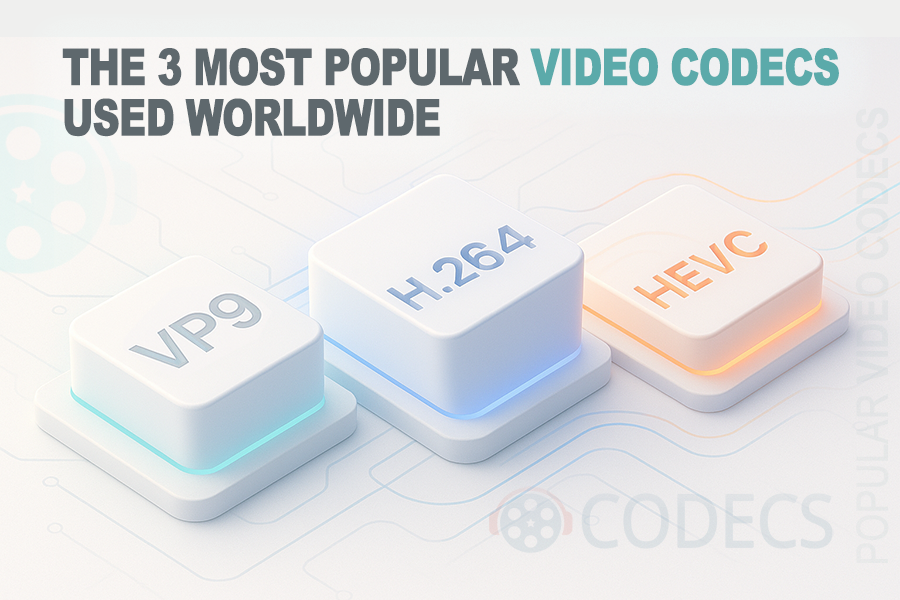Video codecs are essential for compressing digital video files and transmitting them over the internet.
There are countless video codecs available, but only a few have achieved global popularity due to their widespread use across different platforms and devices.
We will discuss the three most used video codecs in the world, as well as one additional codec that is gaining popularity.
H.264/AVC - The Longstanding King of Codecs
H.264 remains the dominant video codec worldwide. It’s the industry standard for compatibility and has been in use for over a decade, providing a reliable balance between video quality and file size.
✅ Key Facts:
-
Full name: Advanced Video Coding (AVC)
-
Released: 2003
-
Developed by: ITU-T & MPEG
-
Use cases: Streaming (YouTube, Vimeo), Blu-ray discs, video conferencing
💡 Why It's Popular:
H.264 offers an excellent balance between compression efficiency, video quality, and hardware compatibility. It became the global standard in the 2010s and remains dominant in many consumer applications.
📈 Strengths:
-
Broad hardware support (phones, TVs, GPUs)
-
High-quality video at relatively low bitrates
-
Backed by mature editing and playback software
⚠️ Limitations:
-
Royalty licensing required for commercial use
-
Less efficient than newer codecs like HEVC or AV1
Download H.264/AVC
H.265/HEVC - High Efficiency for the 4K Era
HEVC improves on H.264 by offering up to 50% better compression at the same quality, making it a go-to for Ultra HD, 4K, and HDR content. It’s widely used in premium media delivery where bandwidth matters.
✅ Key Facts:
-
Full name: High Efficiency Video Coding
-
Released: 2013
-
Developed by: MPEG & VCEG
-
Use cases: 4K UHD content, streaming platforms (Netflix, Prime Video), video archiving
💡 Why It's Popular:
HEVC offers up to 50% better compression than H.264 while maintaining the same image quality, making it perfect for 4K and HDR video. It’s widely supported in modern hardware and professional workflows.
📈 Strengths:
-
Superior compression for high-resolution content
-
Ideal for streaming over limited bandwidth
-
Supported by most 4K devices and TVs
⚠️ Limitations:
-
Complex licensing and royalty structure
-
Slower software-based decoding (unless hardware-accelerated)
Download H.265/HEVC
VP9 (Developed by Google)
VP9 is Google’s open and royalty-free video codec that became popular as a high-efficiency alternative to H.264.
While not as advanced as AV1, it offers significantly better compression than H.264 without the licensing burden of HEVC.
✅ Key Facts:
-
Released: 2013
-
Developed by: Google
-
Use cases: YouTube, web browsers (Chrome, Firefox), Android devices
💡 Why It's Popular:
VP9 is a royalty-free alternative to HEVC, offering similar compression efficiency with widespread support, especially on the web. It's the default codec for YouTube HD and 4K playback on most platforms.
📈 Strengths:
-
Free and open-source
-
Strong browser and Android support
-
High compression efficiency, especially for streaming
⚠️ Limitations:
-
Limited hardware support compared to H.264
-
Slower encoding performance in some cases
Download VP9 Codec
Honorable Mention: AV1
While not yet as widely adopted as the top 3, AV1 is quickly gaining momentum.
Developed by the Alliance for Open Media (AOMedia), AV1 is a royalty-free successor to both VP9 and HEVC, offering superior compression and excellent performance on modern hardware.
🌱 Growing Adoption:
AV1 is now supported by YouTube, Netflix, Facebook, and integrated into major browsers like Chrome and Firefox. It’s built into Android, Windows 11, and many new GPUs and smart TVs.
🚀 Outlook:
As hardware support becomes more common, AV1 is poised to become the future standard for web video and streaming.
Download AV1 Codec
H.264/AVC, VP9, and H.265/HEVC are the three most widely used video codecs in the world, with AV1 being a newer codec that is gaining popularity.
Each codec offers its own unique advantages and disadvantages, and the choice of codec will depend on the specific requirements of the application.















How to Download HEVC Video Extension for Free
actually worked, made my day better icl
Read More →Best Player for Subtitles (2025 Guide)
@P.A. Blok You're right, thanks for the feedback! We've updated the guide to clarify that VLC does auto-detect ...
Read More →How to Play HEVC Files in VLC Media Player (2...
@VanguardLH You're right, it'll be corrected. Thanks for pointing it out!
Read More →